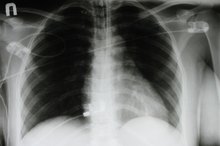What does fact checked mean?
At Healthfully, we strive to deliver objective content that is accurate and up-to-date. Our team periodically reviews articles in order to ensure content quality. The sources cited below consist of evidence from peer-reviewed journals, prominent medical organizations, academic associations, and government data.
The information contained on this site is for informational purposes only, and should not be used as a substitute for the advice of a professional health care provider. Please check with the appropriate physician regarding health questions and concerns. Although we strive to deliver accurate and up-to-date information, no guarantee to that effect is made.
How to Clear Lungs of Phlegm
Phlegm is thick, sticky, stringy mucus that comes from the lungs. There are innumerable diseases that can cause production of phlegm. Individuals diagnosed with chronic obstructive pulmonary disease (COPD), asthma or bronchitis will have extra phlegm in their lungs. It is important to eliminate phlegm from your lungs, since if it stays or accumulates, your airways can become clogged, causing shortness of breath. The phlegm may also become infected. By employing the method of controlled coughing, you can effectively rid your lungs of phlegm 2.
If you are experiencing serious medical symptoms, seek emergency treatment immediately.
Grab a comfortable chair, sit up with your back straight and lean your head slightly forward. Place your hands on your lap and breathe normally for about 30 seconds.
Breathing Exercises to Improve an Upper Respiratory Infection
Learn More
Slowly tilt your head backward and take a slow, deep breath through your nose. Hold your breath for four seconds while your head is still slightly tilted backward.
Lean forward and cough once to loosen the phlegm. Cough a second time to move the phlegm up your throat. Do small, short coughs, and avoid forceful large blasts of air. Try your best not to inhale between the first and second cough. If you must, breathe in very slowly and not too deeply.
How to Stop a Gagging Cough
Learn More
Wait about three seconds. Gently breathe in. Do not take a deep breath since this can cause phlegm to be pushed back into your airways and lungs, making you cough again.
Relax for a few seconds. Repeat steps 1 through 4 three times, or until your airways have been cleared of phlegm.
Related Articles
References
- "Current Diagnosis & Treatment in Pulmonary Medicine"; Michael Hanley, MD; 2003
- Controlled Coughing
- Lillehoj EP, Kato K, Lu W, Kim KC. Cellular and molecular biology of airway mucins. Int Rev Cell Mol Biol. 2013;303:139-202. doi:10.1016/B978-0-12-407697-6.00004-0
- Bills G, Rose C. Principles of Pharmacology for Respiratory Care. Sudbury, MA: Jones & Bartlett Learning; 2019.
- Fahy JV, Dickey BF. Airway mucus function and dysfunction. N Engl J Med. 2010;363(23):2233-47. doi:10.1056/NEJMra0910061
- Seaton A, Leitch G, Seaton D. Crofton and Douglas's Respiratory Diseases. Hoboken, NJ: Wiley; 2008.
- Scaglione F, Petrini O. Mucoactive agents in the therapy of upper respiratory airways infections: fair to describe them just as mucoactive?. Clin Med Insights Ear Nose Throat. 2019;12:1179550618821930. doi:10.1177/1179550618821930
- American Thoracic Society. (2015). What Are the Signs and Symptoms of COPD?
- Centers for Disease Control and Prevention. (n.d.). Runny Nose (with green or yellow mucus).
- Martínez-girón R, Mosquera-martínez J, Martínez-torre S. Black-Pigmented Sputum. J Cytol. 2013;30(4):274-5.
- Nadel, J.A. (2016). Airway Epithelium and Mucous Secretion. Murray and Nadel's Textbook of Respiratory Medicine. 6th ed. 10, 157-167.
- National Health Service. (2015). Coughing up blood (blood in phlegm).
- Rogers, D.F. (2014). Airway Mucus and the Mucociliary System. Middleton's Allergy: Principles and Practice. 47, 739-753
- Rubin, B.K. (2002). Physiology of Airway Mucus Clearance. Respir Care. 47(7), 761-8
- Barnes, P.J., Drazen, J.M., Rennard, S.I. & Thomson, N.C. (2002). Asthma and COPD: Basic Mechanisms and Clinical Management. Academic Press : Elsevier
Writer Bio
Frank Dioso is a trained medical technologist working for prominent research institutions such as Quest Diagnostics and California Clinical Trials. He has, for many years, ghostwritten clinical trial reports for confidential pharmaceutical drugs and is currently contributing his clinical laboratory science knowledge to online how-to articles.









